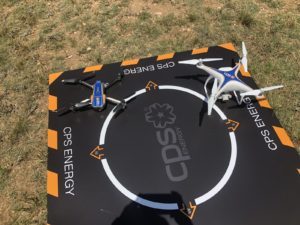
CPS Energy is deploying drone technology to perform routine safer inspections of overhead energy infrastructure.
“We are integrating new technologies to expand our capabilities and operate more efficiently,” said Cris Eugster, Chief Operating Officer at CPS Energy. “Performing inspections with the use of drones helps maintain the safety of our employees and leads to faster inspections of our overhead infrastructure. This proactive effort helps us identify potential issues and mitigate future power outages.”
“As chair of the City’s Innovation and Technology Committee, I am thrilled that CPS Energy is using this innovative, and efficient technology to conduct inspections,” said District 8 Councilman Manny Pelaez. “CPS Energy continues to be a leader in Smart City technologies.”
Last year, CPS Energy (a company that dates to 1860!) premiered drones to inspect transmission towers across high voltage power lines. Pilots completed drone inspections of 50 transmission line towers in just more than two days. “Normally, this work would have taken nearly two weeks to complete using conventional methods,” a CPS spokesperson said. “The utility anticipates drones will be used to inspect equipment approaching its end of life as well as equipment damaged during severe weather.”
“Drones offer the flexibility of performing routine infrastructure inspections from a safe distance whenever challenging or unsafe access issues are present. Rough terrain, obstructions and even animals can slow the progress of obtaining critical information that helps the utility evaluate the performance of their equipment. During times of severe weather, drones can assess impacted areas and help provide information used to prioritize how the utility responds to widespread power outages.”
The company sports two drones in its arsenal and the “utility believes the use of drones will lead to work efficiency, increased productivity, accuracy improvements and enhanced customer service.”
Other uses of drones for energy-sector inspection include:
Drone inspection firm Xcel Energy received permission to survey power lines near Denver. The Minneapolis-based company will deploy drones beyond visual line of the operator’s sight within a designated area approximately 20 miles north of Denver International Airport.
In 2017, a team comprised of AeroVironment, Dominion Virginia Power, the Mid-Atlantic Aviation Partnership last week tested BVLOS powerline inspections using a satellite network and AeroVironment’s Puma, a military-grade, fixed wing drone.
In 2016, the University of Texas partnered with Indian drone-software company Arcturus Business Solutions to better pinpoint weaknesses and damage to transmission lines from the air.
Jason is a longstanding contributor to DroneLife with an avid interest in all things tech. He focuses on anti-drone technologies and the public safety sector; police, fire, and search and rescue.
Beginning his career as a journalist in 1996, Jason has since written and edited thousands of engaging news articles, blog posts, press releases and online content.
Email Jason
TWITTER:@JasonPReagan
Subscribe to DroneLife here.







[…] Source […]